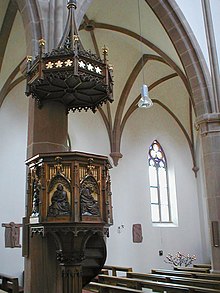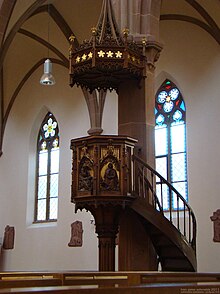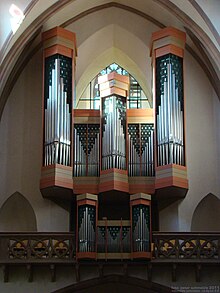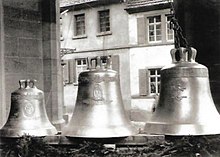Waibstadt parish church
The parish church 'Our Lady' is a Roman Catholic church building in Waibstadt . It is considered to be one of the most distinctive churches in the northern Kraichgau . Because of the 65 m high tower that can be seen from afar, the church building is also known as the " Dom des Kraichgau". The church serves as a parish church for the Roman Catholic parish Maria Himmelfahrt Waibstadt and as an event location for other celebrations such as theater performances or concerts.
history
The predecessor of today's church building stood on today's market square. It was completed in 1826 and consecrated on December 24, 1826. Just five years after completion, the church building showed considerable defects and damage. In a devastating storm on March 1, 1831, the church building was badly damaged. The tiles on the roof were completely blown away. A lightning strike in the church tower partially burned the double onion roof dome and the belfry . The masonry cracked as a result of the fire and the penetrating extinguishing water.
Due to the danger of collapse, the parish was advised to demolish the building in 1836 by the Grand Ducal District Office . The bells were removed from the badly damaged belfry and hung on a scaffold next to the church to ring. This makeshift situation lasted until 1886. On March 20, 1837, part of the church tower collapsed and the surrounding buildings were destroyed.
After all proposals to rebuild or renovate the church, which was built in 1826, were rejected, it was decided to build a new one. With the auction on June 17, 1867 the end of the old church was officially decided. The existing high altar was acquired by the Catholic parish , and is still owned by the parish today.
Even before the construction of the Catholic parish church began, there was an extensive redesign of the townscape. Today's Pfarrstrasse was a narrow dead end street up to the city wall in the direction of Sinsheim . In September 1820 a gate was set up in the city wall and a wide street was created outside the former city fortifications (today's main street). Construction sites were developed along the new street.
On October 1, 1865, a major fire devastated large parts of the town center. In the area between Pfarrstrasse-Ochsengasse-Leopoldstrasse-today's Hauptstrasse, ten residential buildings with the associated barns fell victim to him. The 20 pieces of land required for a new building were acquired in 1864. The total price was approx. 26,200 guilders (approx. 427,000 euros). The freed up area was used for the craftsmen who were busy building the church. After the completion of the church, the burned down buildings were rebuilt.
When the burning buildings were extinguished, the population took their time to create work space. This prompted the rushed fire brigades u. a. Neckarbischofsheims and Sinsheims filed a complaint against the city with the grand ducal district office. The result was the establishment of the fire brigade on October 10, 1865 with the same statutes as for Sinsheim and Neckarbischofsheim .
The foundation stone of the church was laid on June 14, 1865 . The foundation stone was blessed with a high mass in the old church and brought to the new location in a procession. On August 30, 1868, Auxiliary Bishop Lothar von Kübel inaugurated the new church. ' Assumption of the Virgin Mary ' (Solemnity August 15th) was chosen as the patronage . The church building therefore bears the name " Our Lady " Waibstadt - Parish "Assumption of Mary".
Until the reform of the deanery in 2008 in the Archdiocese of Freiburg, the city was the seat of the deanery Waibstadt and thus the mother church . Until the 20th century, Waibstadt was the seat of the Waibstadt regional chapter .
Church building
The church interior has a length of 45 meters. The width is 20 meters, the height 17 meters. The height of the church tower is 65 meters, it dominates the cityscape. It is still considered the highest church tower in the Kraichgau today. Inside there are 26 pews, which can accommodate approx. 700–800 people.
The architect responsible for building the church was Karl Dernfeld. He took up the architectural sensibility of the time and designed a neo-Gothic pillar basilica with ribbed vaults and aisles.
Design
The tall stained glass windows in the choir were created in 1962 by Valentin Peter Feuerstein . They are predominantly set in red and blue tones. The window on the left is dedicated to Mary. In its individual fields, viewed from bottom to top, it corresponds to the Johannes window on the right.
The window on the left shows the following motifs:
- Mary in glory
- Wedding at Cana as the beginning of Jesus' public ministry
- Epiphany
- Annunciation by the angel
The window on the right shows the following motifs:
- John in glory
- Dance of Salome and beheading of John the Baptist
- Baptism of Jesus
- Meeting of Mary and Elizabeth
The middle window and thus the central design object of the church is entirely dedicated to Christ. It has the following motifs:
- Maria (left) and Johannes (right) lean towards the middle window, where Christ is enthroned in the mandorla
- The Pentecost miracle - the sending of the Holy Spirit
- The empty tomb with the angel of the resurrection
- Jesus dead in his mother's lap ( Pietà )
Other works by Feuerstein are the tabernacle in the chancel and an altar cross .
The windows outside the choir are decorated with floral ornamentation . They date from the time of the new building in the 19th century. They do not show any image motifs, but are simply designed in color.
The located on the walls of the aisles crossroads comes from Frankfurt sculptor Franz Bernhard . In 1958 he created the Stations of the Cross from terracotta from reddish-burned clay as half-relief panels.
Wood-carved statues of the Mother of God with the baby Jesus and of John the Baptist were installed above the side altars . Both were already integrated into the formerly carved wood side altars of the church. In the course of the second major church renovation, the paint was removed from the statues and the wood was reconditioned and sealed.
On the pillars are the figures of the apostles , which were restored during the church renovation in 2002/2003 . At the triumphal arch itself are Peter and Paul over. The statues were built into the former high altar .
The pulpit is a foundation of the Counts of Helmstatt with their coats of arms and the four evangelists in the coffers made in carpentry Gothic .
Pastor Johannes Nüssle (1850–1864) lamented the emptiness and desolation of the interior of the church at the time on the market square. Therefore, against the will of the parish and foundation council, he commissioned a painting from the artist Marie Ellenrieder . She was supposed to make a "7 shoe high and 4 ½ wide" image of the Virgin Mary for the parish church. The painting remained unfinished, however, as Ellenrieder died before completion in 1863. It is considered one of her last works. In the Lady Chapel reminds a small replica of the work. The original painting with the title Maria with the Child Jesus is in the Städtische Wessenberg-Galerie Konstanz .
organ
The first organ was built around 1867 by the organ builder Mayer (Hainstadt) for the new church. It had 21 registers on two manuals and a pedal . In 1897 the organ was renovated by the Heidelberg organ building workshop Burkhard because it needed repairs.
In 1911 a new organ was purchased for the church. The organ building company Voit was commissioned to build it. In July 1912 it was set up as Opus 1059. The organ had 26 stops on two manuals and a pedal, with 1452 pipes. An electric motor was used to supply the wind. Annual maintenance was contractually agreed with the Walcker organ workshop until the end of the Second World War. Then the company Kemper und Sohn was commissioned as a maintenance company.
In 1971 the parish decided to rebuild the organ as the restoration and renovation of the old one would have been too uneconomical. On February 18, 1973, the instrument was inaugurated as Opus 121 by the organ building company Vleugels . The Vleugels organ has 30 sounding registers on two manuals and a pedal with a total of 2165 pipes.
In 2002/2003 the instrument was completely overhauled by Vleugels. In the course of this, octave couplers and a crescendo cylinder as well as a cymbal star with six small bronze bowls were installed, as well as a new gaming table . The purely electric action has been replaced by a mechanical-electrical action with setting options for the button pressure point. The organ prospectus was given a new color and cornices with veil grids were placed over the prospectus pipes. A special feature are the foot pedals of the crescendo cylinder and the still missing physharmonica . The stainless steel panels used are the result of the Audi TT .
|
|
|
|||||||||||||||||||||||||||||||||||||||||||||||||||||||||||||||||||||||||||
- = Newly added in 2003
Bells
It is assumed that there was already a polyphonic bell ringing in the old church. The bells that were present in the old church were transferred to the new church. Including the oldest bell f 'from 1506, cast by Bernhart Lachamann .
The bell bore the inscription:
"OSSANA, IN OUR FRAWEN I AM ME: 1506"
In May 1898 a new bell was cast because an old one had cracked. The causes of the cracking are unclear. The newly cast bell was consecrated to Michael. The "Michael's bell" bore the inscription:
"St. My name is Michael, I announce the departing hour to mortals with an iron mouth ”.
In 1917, by order of the War Ministry, the bells had to be removed from the tower and sacrificed for the manufacture of armaments. Among other things, a magnificently decorated bell from 1875, cast by Bachert in Dallau, had to be suspended, as well as a smaller bell from 1880, also cast by Bachert. The bell from 1506 was allowed because of its historical value and the inscription in the tower, which is considered a work of art remain. The second bell from the tower of the Marienkapelle , cast in 1911 by Benjamin Grüninger and Sons Villingen , was also suspended. It bore the inscription:
"Johannes Baptista ora pro nobis"
After the First World War none of the bells returned to Waibstadt and it was decided to cast new bells in the right harmony. In 1922 the new bells were consecrated and hung in the renewed belfry.
In January 1942, the three largest bells, including the bell from 1506, and the remaining bell in the Lady Chapel were removed again and confiscated for war purposes. After the Second World War , they were lost. A citizen from Waibstadt donated 2.814 kg of bronze bells to cast a completely new four-bell ring. It was decided to hang the small bell, which had been spared from the war, in the church tower of the Marienkapelle.
On November 15, 1950, the bells were cast in the Schilling bell foundry in Heidelberg . The bells are hung from a two-storey, octagonal bell chamber with two compartments . The iron belfry from 1956 was replaced by a wooden belfry in 2002/2003 as part of an extensive renovation. In 2015, new sound shutters were installed, which lead to an improvement in the sound radiation and a reduction in the amount of moisture entering the bell chamber. The ringing of bells was recorded and categorized by the Bell Inspectorate of the Archdiocese of Freiburg and can be accessed online.
The four bells have the following tunings:
The following inscriptions were placed on the bells:
Hosanna:
"My name is Hosanna, to Our Lady Ehr I ring"
Michael ( death knell ):
"Holy Archangel Michael defend us in battle so that we do not perish in the horrors of judgment"
Gabriel ( angelus bell ):
"The angel of the Lord brought the message to Mary: Ave Maria-gratia plena"
Raphael (evening bell for the deceased):
“The Lord lead us the way of peace; and his angel Raphael accompany us so that we can return to our homeland in peace, salvation and joy "
Tower clock
The church tower clock of the town church is a special feature. The entire church tower is owned by the political community. In 1989 the old mechanically operated clockwork with the type number E 350 / c / 2 from Schneider was replaced by a quartz master clock with radio control and automatic summer and winter time change from Reichert. In addition, a programmable ringing order was installed. The old clockwork was in operation from 1955 to 1989 and is on display in the foyer of the town hall.
- Description of the dials
- Diameter: 1650 mm
- Numeral background: black
- Medium firm: coral red RAL 3016
- Roman numerals and hour markers are gold-plated with 24 carat gold leaf
literature
- Catholic parish Waibstadt: 150 years of Waibstadt parish church. (Ed.): Kirchenbau-Förderverein Waibstadt. Waibstadt 2018.
- 1200 years Waibstadt: Contributions to the history of the formerly free imperial city. Waibstadt 1995.
Individual evidence
- ^ Assumption of the Virgin Mary, Waibstadt. Accessed March 31, 2020 .
- ^ Bells / Churches. Accessed March 31, 2020 .
- ↑ Waibstadt Catholic parish : 150 years of Waibstadt parish church . Ed .: Kirchenbau-Förderverein Waibstadt. Waibstadt 2018.
Web links
Coordinates: 49 ° 17 '49.6 " N , 8 ° 55' 12.1" E









